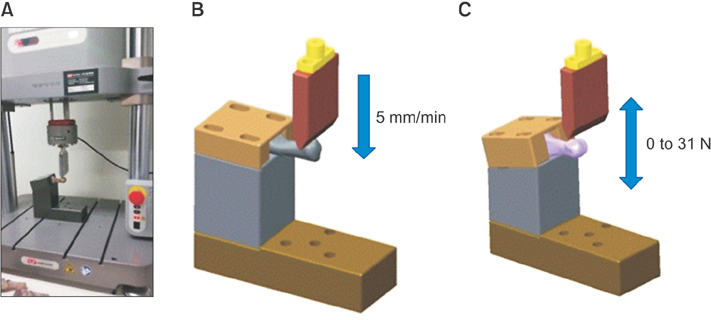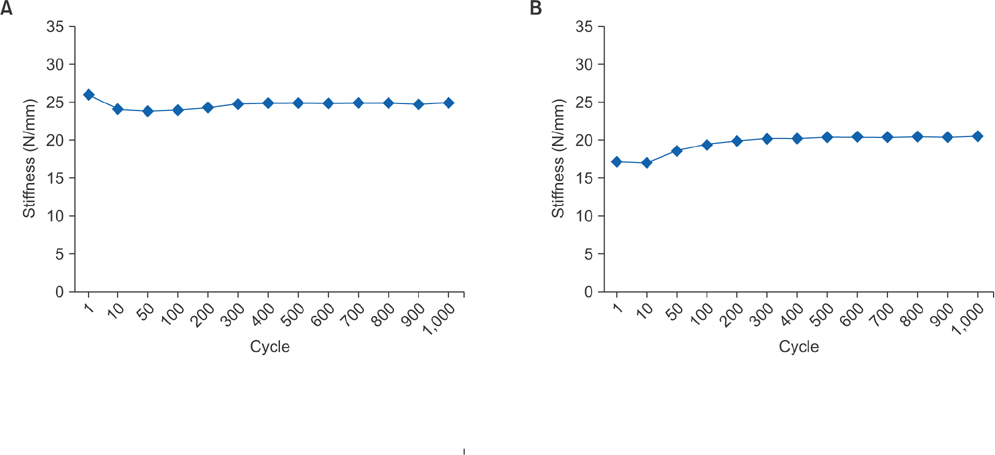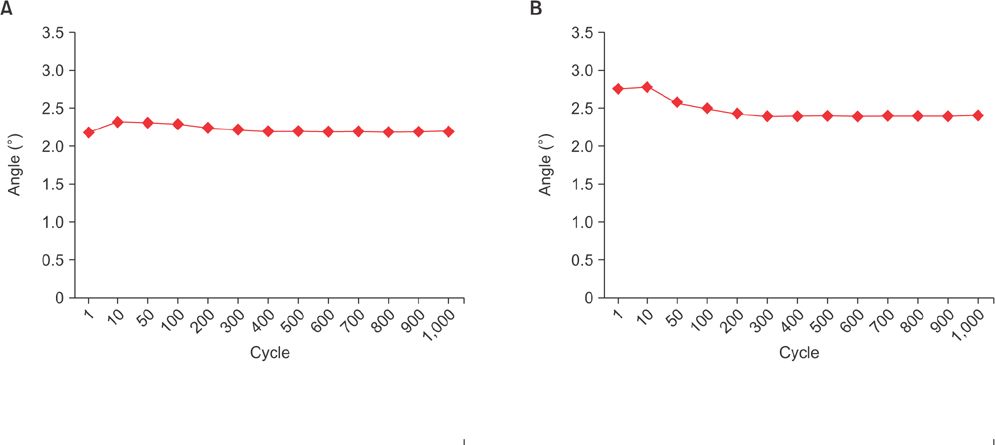Clin Orthop Surg.
2017 Dec;9(4):514-520. 10.4055/cios.2017.9.4.514.
Biomechanical Comparison Study of Three Fixation Methods for Proximal Chevron Osteotomy of the First Metatarsal in Hallux Valgus
- Affiliations
-
- 1Surgery of Foot and Ankle, Department of Orthopedic Surgery, CM Chungmu General Hospital, Seoul, Korea.
- 2Foot and Ankle Clinic, Eulji Medical Center, Eulji University College of Medicine, Seoul, Korea. part4uos@naver.com
- 3KT Lee's Orthopedic Hospital, Seoul, Korea.
- KMID: 2412253
- DOI: http://doi.org/10.4055/cios.2017.9.4.514
Abstract
- BACKGROUND
Fixation of proximal chevron metatarsal osteotomy has been accomplished using K-wires traditionally and with a locking plate recently. However, both methods have many disadvantages. Hence, we developed an intramedullary fixation technique using headless cannulated screws and conducted a biomechanical study to evaluate the superiority of the technique to K-wire and locking plate fixations.
METHODS
Proximal chevron metatarsal osteotomy was performed on 30 synthetic metatarsal models using three fixation techniques. Specimens in group I were fixated with K-wires (1.6 mm × 2) and in group II with headless cannulated screws (3.0 mm × 2) distally through the intramedullary canal. Specimens in group III were fixated with a locking X-shaped plate (1.3-mm thick) and screws (2.5 mm × 4). Eight metatarsal specimens were selected from each group for walking fatigue test. Bending stiffness and dorsal angulation were measured by 1,000 repetitions of a cantilever bending protocol in a plantar to dorsal direction. The remaining two samples from each group were subjected to 5 mm per minute axial loading to assess the maximal loading tolerance.
RESULTS
All samples in group I failed walking fatigue test while group II and group III tolerated the walking fatigue test. Group II showed greater resistance to bending force and smaller dorsal angulation than group III (p = 0.001). On the axial loading test, group I and group II demonstrated superior maximum tolerance to group III (54.8 N vs. 47.2 N vs. 28.3 N).
CONCLUSIONS
Authors have demonstrated proximal chevron metatarsal osteotomy with intramedullary screw fixation provides superior biomechanical stability to locking plate and K-wire fixations. The new technique using intramedullary screw fixation can offer robust fixation and may lead to better outcomes in surgical treatment of hallux valgus.
Keyword
MeSH Terms
Figure
Reference
-
1. Goldie I, Nielsen JM, Lundh N. Hallux valgus: review and results of surgical treatment. Lakartidningen. 1974; 71(1):63–68.2. Aminian A, Kelikian A, Moen T. Scarf osteotomy for hallux valgus deformity: an intermediate followup of clinical and radiographic outcomes. Foot Ankle Int. 2006; 27(11):883–886.
Article3. Coetzee JC, Rippstein P. Surgical strategies: scarf osteotomy for hallux valgus. Foot Ankle Int. 2007; 28(4):529–535.
Article4. Schuh R, Willegger M, Holinka J, Ristl R, Windhager R, Wanivenhaus AH. Angular correction and complications of proximal first metatarsal osteotomies for hallux valgus deformity. Int Orthop. 2013; 37(9):1771–1780.
Article5. Easley ME, Kiebzak GM, Davis WH, Anderson RB. Prospective, randomized comparison of proximal crescentic and proximal chevron osteotomies for correction of hallux valgus deformity. Foot Ankle Int. 1996; 17(6):307–316.
Article6. Scott AT, DeOrio JK, Montijo HE, Glisson RR. Biomechanical comparison of hallux valgus correction using the proximal chevron osteotomy fixed with a medial locking plate and the Ludloff osteotomy fixed with two screws. Clin Biomech (Bristol, Avon). 2010; 25(3):271–276.
Article7. Park CH, Ahn JY, Kim YM, Lee WC. Plate fixation for proximal chevron osteotomy has greater risk for hallux valgus recurrence than Kirschner wire fixation. Int Orthop. 2013; 37(6):1085–1092.
Article8. Mann RA, Rudicel S, Graves SC. Repair of hallux valgus with a distal soft-tissue procedure and proximal metatarsal osteotomy: a long-term follow-up. J Bone Joint Surg Am. 1992; 74(1):124–129.
Article9. Heiner AD, Brown TD. Structural properties of a new design of composite replicate femurs and tibias. J Biomech. 2001; 34(6):773–781.
Article10. Schuh R, Hofstaetter JG, Benca E, et al. Biomechanical analysis of two fixation methods for proximal chevron osteotomy of the first metatarsal. Int Orthop. 2014; 38(5):983–989.
Article11. Trnka HJ. Osteotomies for hallux valgus correction. Foot Ankle Clin. 2005; 10(1):15–33.
Article12. Acevedo JI, Sammarco VJ, Boucher HR, Parks BG, Schon LC, Myerson MS. Mechanical comparison of cyclic loading in five different first metatarsal shaft osteotomies. Foot Ankle Int. 2002; 23(8):711–716.
Article13. Varner KE, Matt V, Alexander JW, et al. Screw versus plate fixation of proximal first metatarsal crescentic osteotomy. Foot Ankle Int. 2009; 30(2):142–149.
Article14. Bong MR, Kummer FJ, Koval KJ, Egol KA. Intramedullary nailing of the lower extremity: biomechanics and biology. J Am Acad Orthop Surg. 2007; 15(2):97–106.
Article15. Shereff MJ, Sobel MA, Kummer FJ. The stability of fixation of first metatarsal osteotomies. Foot Ankle. 1991; 11(4):208–211.
Article16. Jones C, Coughlin M, Petersen W, Herbot M, Paletta J. Mechanical comparison of two types of fixation for proximal first metatarsal crescentic osteotomy. Foot Ankle Int. 2005; 26(5):371–374.
Article17. Gallentine JW, Deorio JK, Deorio MJ. Bunion surgery using locking-plate fixation of proximal metatarsal chevron osteotomies. Foot Ankle Int. 2007; 28(3):361–368.
Article18. Sammarco VJ, Acevedo J. Stability and fixation techniques in first metatarsal osteotomies. Foot Ankle Clin. 2001; 6(3):409–432.
Article19. Lian GJ, Markolf K, Cracchiolo A 3rd. Strength of fixation constructs for basilar osteotomies of the first metatarsal. Foot Ankle. 1992; 13(9):509–514.
Article20. Badwey TM, Dutkowsky JP, Graves SC, Richardson EG. An anatomical basis for the degree of displacement of the distal chevron osteotomy in the treatment of hallux valgus. Foot Ankle Int. 1997; 18(4):213–215.
Article21. Trnka HJ, Parks BG, Ivanic G, et al. Six first metatarsal shaft osteotomies: mechanical and immobilization comparisons. Clin Orthop Relat Res. 2000; (381):256–265.
- Full Text Links
- Actions
-
Cited
- CITED
-
- Close
- Share
- Similar articles
-
- Bioabsorbable Screws Used in Hallux Valgus Treatment Using Proximal Chevron Osteotomy
- Comparison of Proximal Metatarsal Osteotomy andDistal Chevron Osteotomy for Correction of Hallux Valgus
- A Comparison of Operative Treatment of Hallux Valgus with a Proximal Metatarsal Osteotomy and with a Modified Chevron Osteotomy
- The Clinical Results of the Proximal Opening Wedge Osteotomy Using a Low Profile Plate in Hallux Valgus: Comparison with Proximal Chevron Osteotomy Fixed with K-wires
- Proximal Metatarsal Chevron Osteotomy Combined with Modified McBride Procedures for Hallux Valgus Patients.






